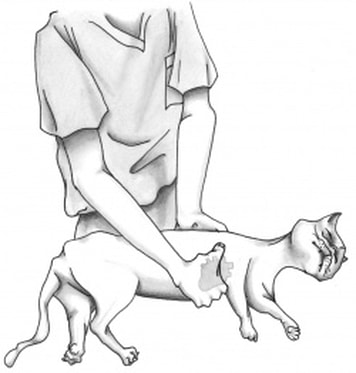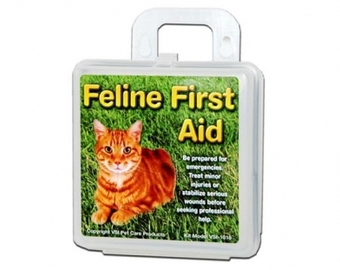Dr Jo Blogs
Expert Cat Care Advice
Feline First Aid
Dr Jo Lewis MRCVS | 10 Aug 2021 | 5 min read
Share:
First ensure the safety of yourself and others. Keep calm and assess the situation before acting. Injured animals are frightened and in pain, and may try to bite anyone who touches them.
Approach your cat quietly and slowly, avoiding sudden movements. The best way of lifting an injured cat is to put one hand under the chest, and the other supporting the hind legs, but be led by where any obvious injuries are and avoid those areas if possible.
If the cat seems frightened and defensive, it is better to lift the cat in a thick towel, but be careful as cats can bite through towels. If you are dealing with an unknown cat, you may be able to encourage the animal into a shed or garage before seeking help. Sometimes cats can be persuaded to run into the safety and security of a cat box, if there is no other obvious escape route. If you are bitten, see your doctor ASAP.
Approach your cat quietly and slowly, avoiding sudden movements. The best way of lifting an injured cat is to put one hand under the chest, and the other supporting the hind legs, but be led by where any obvious injuries are and avoid those areas if possible.
If the cat seems frightened and defensive, it is better to lift the cat in a thick towel, but be careful as cats can bite through towels. If you are dealing with an unknown cat, you may be able to encourage the animal into a shed or garage before seeking help. Sometimes cats can be persuaded to run into the safety and security of a cat box, if there is no other obvious escape route. If you are bitten, see your doctor ASAP.
Never give human medicines to a cat, and do not offer food or drink in case your pet has to have an urgent anaesthetic. The only exception to this is if your cat is a known diabetic on treatment - then you may wipe oral glucose gel or honey / corn syrup on their gums while contacting your vet provided they are able to swallow.
Any cat with breathing difficulties should be handled carefully and gently, particularly if they are breathing with an open mouth. Many of these patients are dangerously ill and can collapse suddenly if upset.
Drive carefully when going to the surgery and always have the cat in a closed box or carrier for transport. Take with you any medications your cat is on or any parasite treatments or toxins your cat may have been exposed to.
Any cat with breathing difficulties should be handled carefully and gently, particularly if they are breathing with an open mouth. Many of these patients are dangerously ill and can collapse suddenly if upset.
Drive carefully when going to the surgery and always have the cat in a closed box or carrier for transport. Take with you any medications your cat is on or any parasite treatments or toxins your cat may have been exposed to.
Basic feline resuscitation
- Ideally get someone else to call ahead to your vet and take you and your cat there ASAP and attempt CPR in transit. Be sure to avoid any movement of the head, neck and spine as you would for humans.
- Put the cat on their side and check that breathing has definitely stopped (no rising/falling of chest, hold a wisp of fur to the nostrils to check for air flow - hold your own breath while you do this to avoid any false movements).
- Open the mouth, pull the tongue forwards and check for obstructions, such as blood.
- Be careful not to get bitten when removing any material.
- If breathing does not start, extend the head (pointing the nose forwards).
- Hold the mouth closed, and blow into the nose about ten times per minute.
- If you cannot feel a heartbeat, push on the chest just behind the forelegs level with the cat's elbow every one or two seconds. Give two breaths into the nose for every 15 pushes on the chest.
- If this is unsuccessful after three minutes, recovery is unlikely but always continue to your vet to double check and to try and get to the bottom of what was wrong.
Checklist for your feline first aid kit
- Bandages – a roll of self-adhesive or crepe bandage (five centimetres width)
- Conforming or open-weave bandages (two and a half centimetres width)
- Surgical sticky tape (eg Steri-Strips)
- Box of cotton wool
- Box of sterile absorbent gauze or a packet of swabs
- Some non-adhesive absorbent dressings (five centimetres square) to cover open wounds
- Blunt-ended scissors, preferably curved
- Thick towel
- Elizabethan collar (AKA lampshade, cone of shame)
- Bottle of sterile saline solution







